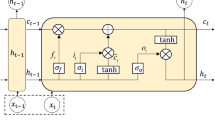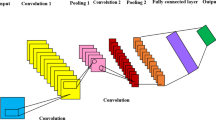Abstract
Real-time dynamic adjustment of the tunnel bore machine (TBM) advance rate according to the rock-machine interaction parameters is of great significance to the adaptability of TBM and its efficiency in construction. This paper proposes a real-time predictive model of TBM advance rate using the temporal convolutional network (TCN), based on TBM construction big data. The prediction model was built using an experimental database, containing 235 data sets, established from the construction data from the Jilin Water-Diversion Tunnel Project in China. The TBM operating parameters, including total thrust, cutterhead rotation, cutterhead torque and penetration rate, are selected as the input parameters of the model. The TCN model is found outperforming the recurrent neural network (RNN) and long short-term memory (LSTM) model in predicting the TBM advance rate with much smaller values of mean absolute percentage error than the latter two. The penetration rate and cutterhead torque of the current moment have significant influence on the TBM advance rate of the next moment. On the contrary, the influence of the cutterhead rotation and total thrust is moderate. The work provides a new concept of real-time prediction of the TBM performance for highly efficient tunnel construction.
Similar content being viewed by others
Data Availability Statement Some or all data, models, or code that support the findings of this study are available from the corresponding author upon reasonable request, including the model code developed by the authors, and the TBM data collected.
References
Qi M. Promoting TBM in tunnel construction in China. Tunnel Construction, 2014, 34(11): 1019–1023 (in Chinese)
Shang Y, Yang Z, Qi Z, Sun Y, Shi Y, Yuan G. Retrospective analysis of TBM accidents from its poor flexibility to complicated geological conditions. Chinese Journal of Rock Mechanics and Engineering, 2007, 26(12): 2404–2411 (in Chinese)
Li L, Liu Z, Zhou H, Qi W, Zha W. Weighted voting model for advanced intelligent perception of tunnel faults based on TBM rock-machine information. Chinese Journal of Rock Mechanics and Engineering, 2020, 39(S2): 3401–3411 (in Chinese)
Liu Q, Liu J, Pan Y, Kong X. Research advances of tunnel boring machine performance prediction models for hard rock. Chinese Journal of Rock Mechanics and Engineering, 2016, 35(S1): 2766–2786 (in Chinese)
Khademi F, Akbari M, Jamal S M, Nikoo M. Multiple linear regression, artificial neural network, and fuzzy logic prediction of 28 days compressive strength of concrete. Frontiers of Structural and Civil Engineering, 2017, 11(1): 90–99
Sharafati A, Naderpour H, Salih S Q, Onyari E, Yaseen Z M. Simulation of foamed concrete compressive strength prediction using adaptive neuro-fuzzy inference system optimized by nature-inspired algorithms. Frontiers of Structural and Civil Engineering, 2021, 15(1): 61–79
Chen R, Zhang P, Wu H, Wang Z, Zhong Z. Prediction of shield tunneling-induced ground settlement using machine learning techniques. Frontiers of Structural and Civil Engineering, 2019, 13(6): 1363–1378
Liu Z, Shao J, Xu W, Wu Q. Indirect estimation of unconfined compressive strength of carbonate rocks using extreme learning machine. Acta Geotechnica, 2015, 10(5): 651–663
Lin S, Zheng H, Han C, Han B, Li W. Evaluation and prediction of slope stability using machine learning approaches. Frontiers of Structural and Civil Engineering, 2021, 15(4): 821–833
Liu Z, Shao J, Xu W, Chen H, Zhang Y. An extreme learning machine approach for slope stability evaluation and prediction. Natural Hazards, 2014, 73(2): 787–804
Gordan B, Jahed Armaghani D, Hajihassani M, Monjezi M. Prediction of seismic slope stability through combination of particle swarm optimization and neural network. Engineering with Computers, 2016, 32(1): 85–97
Liu Z, Shao J, Xu W, Chen H, Shi C. Comparison on landslide nonlinear displacement analysis and prediction with computational intelligence approaches. Landslides, 2014, 11(5): 889–896
Hoang N D, Tien Bui D. A novel relevance vector machine classifier with cuckoo search optimization for spatial prediction of landslides. Journal of Computing in Civil Engineering, 2016, 30(5): 04016001
Tabarsa A, Latifi N, Osouli A, Bagheri Y. Unconfined compressive strength prediction of soils stabilized using artificial neural networks and support vector machines. Frontiers of Structural and Civil Engineering, 2021, 15(2): 520–536
Jing L, Li J, Zhang N, Chen S, Yang C, Cao H. A TBM advance rate prediction method considering the effects of operating factors. Tunnelling and Underground Space Technology, 2021, 107: 103620
Hassanpour J, Rostami J, Khamehchiyan M, Bruland A. Developing new equations for TBM performance prediction in carbonate-argillaceous rocks: A case history of Nowsood water conveyance tunnel. Geomechanics and Geoengineering, 2009, 4(4): 287–297
Samaei M, Ranjbarnia M, Nourani V, Zare Naghadehi M. Performance prediction of tunnel boring machine through developing high accuracy equations: A case study in adverse geological condition. Measurement, 2020, 152: 107244
Yagiz S, Karahan H. Prediction of hard rock TBM penetration rate using particle swarm optimization. International Journal of Rock Mechanics and Mining Sciences, 2011, 48(3): 427–433
Fattahi H, Babanouri N. Applying optimized support vector regression models for prediction of tunnel boring machine performance. Geotechnical and Geological Engineering, 2017, 35(5): 2205–2217
Mahdevari S, Shahriar K, Yagiz S, Akbarpour Shirazi M. A support vector regression model for predicting tunnel boring machine penetration rates. International Journal of Rock Mechanics and Mining Sciences, 2014, 72: 214–229
Ghasemi E, Yagiz S, Ataei M. Predicting penetration rate of hard rock tunnel boring machine using fuzzy logic. Bulletin of Engineering Geology and the Environment, 2014, 73(1): 23–35
Armaghani D J, Yagiz S, Mohamad E T, Zhou J. Prediction of TBM performance in fresh through weathered granite using empirical and statistical approaches. Tunnelling and Underground Space Technology, 2021, 118: 104183
Yang H, Wang Z, Song K. A new hybrid grey wolf optimizer-feature weighted-multiple kernel-support vector regression technique to predict TBM performance. Engineering with Computers, 2020: 1–17
Jahed Armaghani D, Faradonbeh R S, Momeni E, Fahimifar A, Tahir M. Performance prediction of tunnel boring machine through developing a gene expression programming equation. Engineering with Computers, 2018, 34(1): 129–141
Zare Naghadehi M, Samaei M, Ranjbarnia M, Nourani V. State-of-the-art predictive modeling of TBM performance in changing geological conditions through gene expression programming. Measurement, 2018, 126: 46–57
Moradi M R, Farsangi M A E. Application of the risk matrix method for geotechnical risk analysis and prediction of the advance rate in rock TBM tunneling. Rock Mechanics and Rock Engineering, 2014, 47(5): 1951–1960
Zhou J, Qiu Y, Zhu S, Armaghani D J, Li C, Nguyen H, Yagiz S. Optimization of support vector machine through the use of metaheuristic algorithms in forecasting TBM advance rate. Engineering Applications of Artificial Intelligence, 2021, 97: 104015
Gao X, Shi M, Song X, Zhang C, Zhang H. Recurrent neural networks for real-time prediction of TBM operating parameters. Automation in Construction, 2019, 98: 225–235
Benardos A G, Kaliampakos D C. Modelling TBM performance with artificial neural networks. Tunnelling and Underground Space Technology, 2004, 19(6): 597–605
Zhou J, Bejarbaneh B Y, Armaghani D J, Tahir M M. Forecasting of TBM advance rate in hard rock condition based on artificial neural network and genetic programming techniques. Bulletin of Engineering Geology and the Environment, 2019, 79(2): 2069–2084
Armaghani D J, Mohamad E T, Narayanasamy M S, Narita N, Yagiz S. Development of hybrid intelligent models for predicting TBM penetration rate in hard rock condition. Tunnelling and Underground Space Technology, 2017, 63: 29–43
Koopialipoor M, Fahimifar A, Ghaleini E N, Momenzadeh M, Armaghani D J. Development of a new hybrid ANN for solving a geotechnical problem related to tunnel boring machine performance. Engineering with Computers, 2020, 36(1): 345–357
Armaghani D J, Koopialipoor M, Marto A, Yagiz S. Application of several optimization techniques for estimating TBM advance rate in granitic rocks. Journal of Rock Mechanics and Geotechnical Engineering, 2019, 11(4): 779–789
Zeng J, Roy B, Kumar D, Mohammed A S, Armaghani D J, Zhou J, Mohamad E T. Proposing several hybrid PSO-extreme learning machine techniques to predict TBM performance. Engineering with Computers, 2021: 1–17
Zhou J, Qiu Y, Zhu S, Armaghani D J, Mohamad E T. Estimation of the TBM advance rate under hard rock conditions using XGBoost and Bayesian optimization. Underground Space, 2021, 6(5): 506–515
Rumelhart D E, Hinton G E, Williams R J. Learning representations by back propagating errors. Nature, 1986, 323(6088): 533–536
Bengio Y, Simard P, Frasconi P. Learning long-term dependencies with gradient descent is difficult. IEEE Transactions on Neural Networks, 1994, 5(2): 157–166
Chen H, Xiao C, Yao Z, Jiang H, Guan Y. Prediction of TBM tunneling parameters through an LSTM neural network. In: 2019 IEEE International Conference on Robotics and Biomimetics (ROBIO). Dali: IEEE, 2019: 702–707
Liu Z, Li L, Fang X, Qi W, Shen J, Zhou H, Zhang Y. Hard-rock tunnel lithology prediction with TBM construction big data using a global-attention-mechanism-based LSTM network. Automation in Construction, 2021, 125: 103647
Qin S, Xu T, Zhou W. Predicting pore-water pressure in front of a TBM using a deep learning approach. International Journal of Geomechanics, 2021, 21(8): 04021140
Bai S, Kolter J Z, Koltun V. An empirical evaluation of generic convolutional and recurrent networks for sequence modeling. 2018, arXiv:1803.01271
Oord A, Dieleman S, Zen H, Simonyan K, Vinyals O, Graves A, Kalchbrenner N, Senior A, Kavukcuoglu K. Wavenet: A generative model for raw audio. 2016, arXiv:1609.03499
Yu F, Koltun V. Multi-scale context aggregation by dilated convolution. 2015, arXiv: 1511.07122
Zhou F, Jin L, Dong J. Review of convolutional neural network. Chinese Journal of Computers, 2017, 40(6): 1229–1251 (in Chinese)
Strubell E, Verga P, Belanger D, McCallum A. Fast and accurate entity recognition with iterated dilated convolutions. In: Proceedings of the 2017 Conference on Empirical Methods in Natural Language Processing, Honolulu, HI: Association for Computational Linguistics, 2017: 2670–2680
Raschka S. Python Machine Learning. Birmingham: Packt Publishing Ltd., 2015
Nair V, Hinton G E. Rectified linear units improve restricted boltzmann machines. In: Proceedings of the 27th International Conference on Machine Learning. Haifa: Omnipress, 2010: 807–814
Ioffe S, Szegedy C. Batch normalization: Accelerating deep network training by reducing internal covariate shift. In: Proceedings of the 32nd International Conference on Machine Learning. Lille: PMLR, 2015: 448–456
Kingma D, Ba J. Adam: A method for stochastic optimization. 2014, arXiv:1412.6980
Jamieson K, Talwalkar A. Non-stochastic best arm identification and hyperparameter optimization. In: The 19th International Conference on Artificial Intelligence and Statistics. Cadiz: PMLR, 2016: 240–248
Graves A, Mohamed A, Hinton G. Speech recognition with deep recurrent neural networks. In: 2013 IEEE international conference on acoustics, speech and signal processing. Las Vegas, NV: IEEE, 2013: 6645–6649
Baldi P, Sadowski P. The dropout learning algorithm. Artificial Intelligence, 2014, 210: 78–122
Acknowledgements
The authors acknowledge the support of intelligent control and support software to safely and efficiently operate TBM tunnels from China Railway Engineering Equipment Group Co., Ltd. and the project team for the National Basic Research Program (973 program). Supports from National Natural Science Foundation of China (Grant No. 11902069), Sichuan University, State Key Lab Hydraul & Mt River Engn (No. SKHL1915), and the Research Project of China Railway First Survey and Design Institute Group Co., Ltd (No. 19-15 and No. 20-17-1) are also acknowledged. The work is partially supported by the 111 Project (B17009) and under the framework of Sino-Franco Joint Research Laboratory on Multiphysics and Multiscale Rock Mechanics.
Author information
Authors and Affiliations
Corresponding author
Rights and permissions
About this article
Cite this article
Liu, Z., Wang, Y., Li, L. et al. Realtime prediction of hard rock TBM advance rate using temporal convolutional network (TCN) with tunnel construction big data. Front. Struct. Civ. Eng. 16, 401–413 (2022). https://doi.org/10.1007/s11709-022-0823-3
Received:
Accepted:
Published:
Issue Date:
DOI: https://doi.org/10.1007/s11709-022-0823-3




